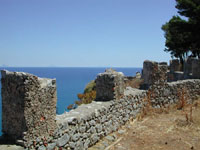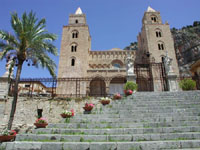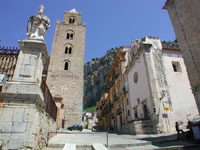 |
ARTS
AND MONUMENTS |
 |
|
|
 The
Castle of the Rocca, dating from the XIII century, has a
long and eventful history. The
Castle of the Rocca, dating from the XIII century, has a
long and eventful history.
Its possession was long disputed between Federico II and the Bishop
of Cefalù, Arduino, this latter prevailing.
It was the prison of Carlo II, then sold, under Alfonso V Aragona,
to the Ventimiglia family and finally bought by the Bishop Sarzana.
The construction has a rectangular plant with two towers. Its remains
are protected both by the strategic position on top of the rock
which overlooks the town, and by the castle walls.
| Sanctuary
and museum of Gibilmanna |
 |
 |
 |
 The
Sanctuary of Gibilmanna is consecrated to the Virgin Mary.
The name has Arabic origin and refers to "Gibel el Mann",
meaning Mount of the Manna, or even to "Gibel el Iman",
Mount of the Faith. The
Sanctuary of Gibilmanna is consecrated to the Virgin Mary.
The name has Arabic origin and refers to "Gibel el Mann",
meaning Mount of the Manna, or even to "Gibel el Iman",
Mount of the Faith.
Situated on the slopes of the Sant'Angelo Peak and spanned by woods
with plenty of beeches, cork-trees, elms, chestnuts and ashes, this
site has an intimate and peaceful charm.
It has remotest roots, running back to the settlement of the Benedictine
coenobitic communities, wanted by Pope Gregorio Magno. Other important
religious orders have afterwards contributed to enrich this place.
The building was much changed over the centuries, especially during
the Baroque period.
The inside is rich of examples of the holy figurative art, such
as a chapel dedicated to the Virgin Mary, dating from the earliest
XVII century and containing a notable Byzantine fresco: "The
Virgin and the Child".
The museum, inside housed, adds historic and cultural value to the
holy construction. It shows sacred paraments, tools and works made
of poorest material, after the Franciscan rule.
Noteworthy are some works from the workplaces and from the Capuchins'
workrooms and some anthropologic finds, evidence of the "do-it-yourself"
art preached by the Friars.
Also worth mentioning are some paintings, being an historic report
on the protagonists of Gibilmanna and of the religious order, such
as those representing Friar Sebastiano, the founder of the Monastery,
San Francesco and Santa Chiara.
According
to the Franciscan atmosphere of poverty, breathable all over, the
museum does not hold any works of very illustrious artists or notably
valued.
The museum, is dedicated to Frà Giammaria di Tusa, a friar
who lived in the XVI century.
 The
town museum is situated just in front of the mentioned Gibilmanna
Sanctuary. It was founded in the past century by the homonymous
cultural foundation set up by the noble Enrico Pirajno di Mandralisca,
illustrious scholar, collector and patriot. The
town museum is situated just in front of the mentioned Gibilmanna
Sanctuary. It was founded in the past century by the homonymous
cultural foundation set up by the noble Enrico Pirajno di Mandralisca,
illustrious scholar, collector and patriot.
The museum is divided into several divisions: the library, the picture-gallery,
the archaeological, the numismatic and the malacology divisions.
Numerous important finds are here preserved like a Greek funerary
inscription from the II century b.C. and a remarkable numismatic
collection containing minting dies from some of the most important
city-state of ancient Sicily, of Cefalù and Lipari.
An important library enriches the museum. Worth-mentioning cultural
and historic books are here contained, including two incunabulum
and some XVI century pieces.
The most famous and valued work is a painting by Antonello da Messina
called "Portrait of an Unknown".
The picture-gallery is very renowned and collects works ranging
over five centuries of history, from the XV to the XIX.
The archaeologic division shows finds unearthed on the surrounding
area and in the Eolie islands.
Another worth-mentioning piece is the splendid fourth-century B.C.
bowl with the "tuna salesman", an eighteenth-century sedan
chair.
 This
magnificent monument, dating back to the Norman domination, is likely
the best beautiful of all Cefalù. This
magnificent monument, dating back to the Norman domination, is likely
the best beautiful of all Cefalù.
According to the legend, the noble Ruggero II wanted its construction
in 1131 to fulfil a vow made on having survived a violent sea storm,
disembarking in fact, in this lovely town.
This legend apart, it strikes the absolute lack of information on
the may-have-been politic or economic reasons which took Ruggero
in this smallest city of the reign.
It remains however the dominant presence of this monument, to be
sure among the best legacies that the Normans, notoriously promoters
of development and art, left to Sicily.
The figure of the cathedral is imposing,
even strengthened by the two majestic towers with battlements that
frame the façade. The landscape from here is not less i mpressive,
overlooking all the old town and spanned between a blue-sea horizon
and the wild beauty of the mountain, at a distance. mpressive,
overlooking all the old town and spanned between a blue-sea horizon
and the wild beauty of the mountain, at a distance.
All the major architectural techniques of the time bore on the construction:
Egyptian, Muslim and Byzantine.
The Cathedral or, as they call it here, Duomo, was built on an already
urbanized area as testified by the mosaic and the remains of an
ancient roman road recovered by archaeologic excavations.
Upon Ruggero II's death, the church, still maintaining its beauty,
began declining while some detail suggested that the original project
had not been fully completed. The assumption that the cathedral
had been conceived as a Pantheon of the Norman monarchy arose.The
dominant feature of the cathedral, are the two majestic towers with
battlements that frame the façade, where there is a magnificent
portico, with three arches supported by four columns and an imposing,
richly decorated marble portal, dating back to the XV century and
made by Ambrogio da Como. Its original role was that of protecting
the side paintings guarded by the Porta Regnum.
The battlement on the south side and the presence of numerous underground
passages contribute in giving the building the look of a fortress.
The façade construction was ended in 1204.
The interior is on a Latin cross basilica plan with three naves
divided by granite columns and capitals after the Norman-Sicilian
style.
The splendid mosaics in the presbytery have come to symbolize the
church, first of all the figure of the benedictory Christ Pantocrator,
at the centre of the apse.
This representation is much alike many others guarded in the churches
of Sicily.
Other superb mosaics adorn the presbytery, made by the Byzantine
master craftsmen able to melt the Eastern decorative tradition with
the Northern style architecture: the Virgin, the Apostles, the Evangelists
and then the saints, prophets, angels and seraphs are represented.The
cathedral harbours many other works of art: a beautiful Virgin and
Child fresco made by Antonello Gagini in 1533, some funerary monuments
in the basilica and, finally, some impressing neoclassic frescoes
adorning the Chapel of the SS. Sacramento.
The presence of all these different styles bears witness
to the far origin of the cathedral and to the various changes occurred
over the centuries.
Other
monuments add value to the historical importance of Cefalù.
The
church of S. Biagio
The church of S. Biagio, bishop and martyr, rises
on what remained of two other churches: one homonymous and the SS.
Crispino and Crispiniano's church. The few details known about its
origin inform that it was constructed after the closure of another
church that was situated nearby.
The
church of S. Sebastiano
Few is known about the origin of the church of S. Sebastiano.
An inscription on the old façade referred to the year 1523,
possible date of construction. Another holy building is comprised
in the construction: the monastery of S. Maria del Monte Carmelo.
The church look is very plain and has inside four niches containing
holy images dedicated to S. Sebastiano, S. Teresa and S. Giuseppe,
a wood crucifix and a painting representing the "Madonna del
Carmelo" surrounded by the prophets Elias and St. Albert.
The
church of S. Oliva
The church of S. Oliva was built in 1787 near the
homonymous creek. The plain façade shows a round arch. One
step, at the entrance, bears the year of construction of the church.
The inside has one aisle and shows two interesting frescoes dedicated
to S. Oliva, Virgin and Martyr, and to the Vergine Addolorata.
The
church of Maria SS. della Catena or the "Addoloratella"
It was finished in 1780. About ten years after it was built
the "Collegino dell'Addolarata", a structure that was
to take in needy women, a role first accomplished by the Community
of the S. Vergine Addolorata. This activity however
went on only few years.
The church has a typical XVIII century look and is renowned for
the loggia bore by two pilasters and flanked by two niches that
harbour two interesting lithic statues. A statue of the Virgin is
housed into another niche.
The bell-tower completes the outside structure. It also carries
two clocks from the late XIX century, whose installation necessitated
changes in the tower design.
The church has a plain inside, with one aisle without apse and transept,
and it is renowned for housing a statue dedicated to S. Espedito
and an aedicule dedicated to S. Rocco, Protector of Cefalù.
The
church of the Purgatory
Built on a site where were formerly located the chapel of S.
Margherita and the church of S. Stefano, the
church "del Purgatorio" is one of the fewest
baroque examples in Cefalù. The façade is enriched
with various figures of souls in purgatory and masks.
Inside, the church preserves the chapels of the "Crocifisso"
and of San Pietro, this latter harbouring the statue of the "Madonna
Addolorata".
Church
of S. Giorgio and S. Leonardo
Dedicated to S. Leonardo in 1648, this church dates,
as attested by historic documents, from the Ruggero's reign and
was dedicated to S. Giorgio. It remains of the original
construction only an interesting portal with an ogival arch.
The plain inside has a hall design and an interesting chorus room.
|

